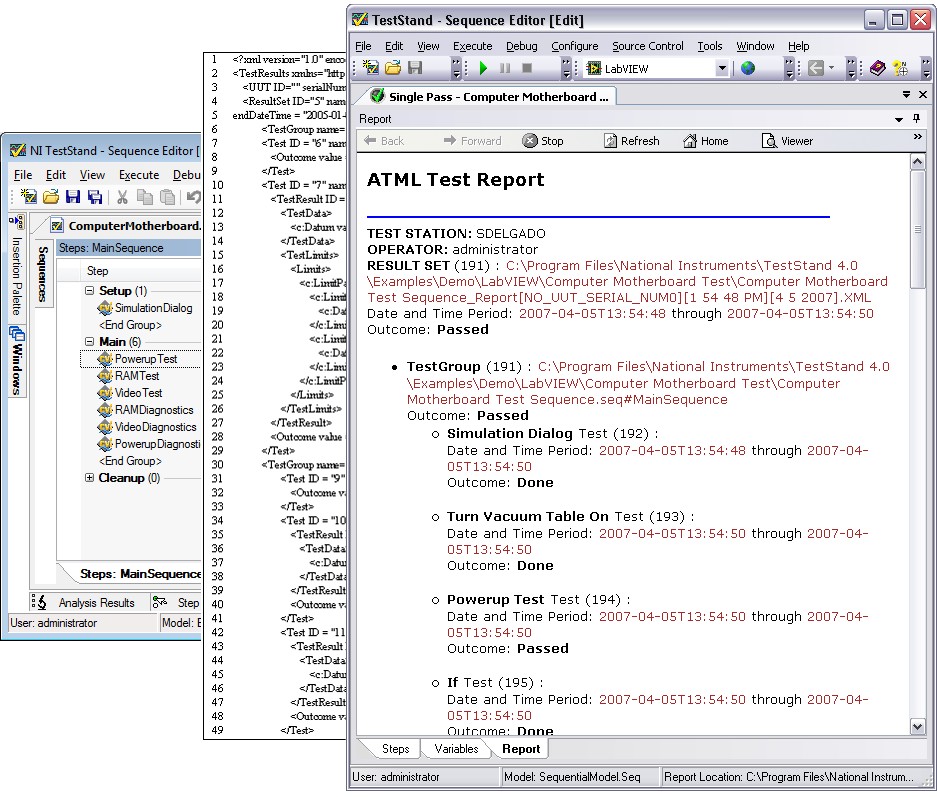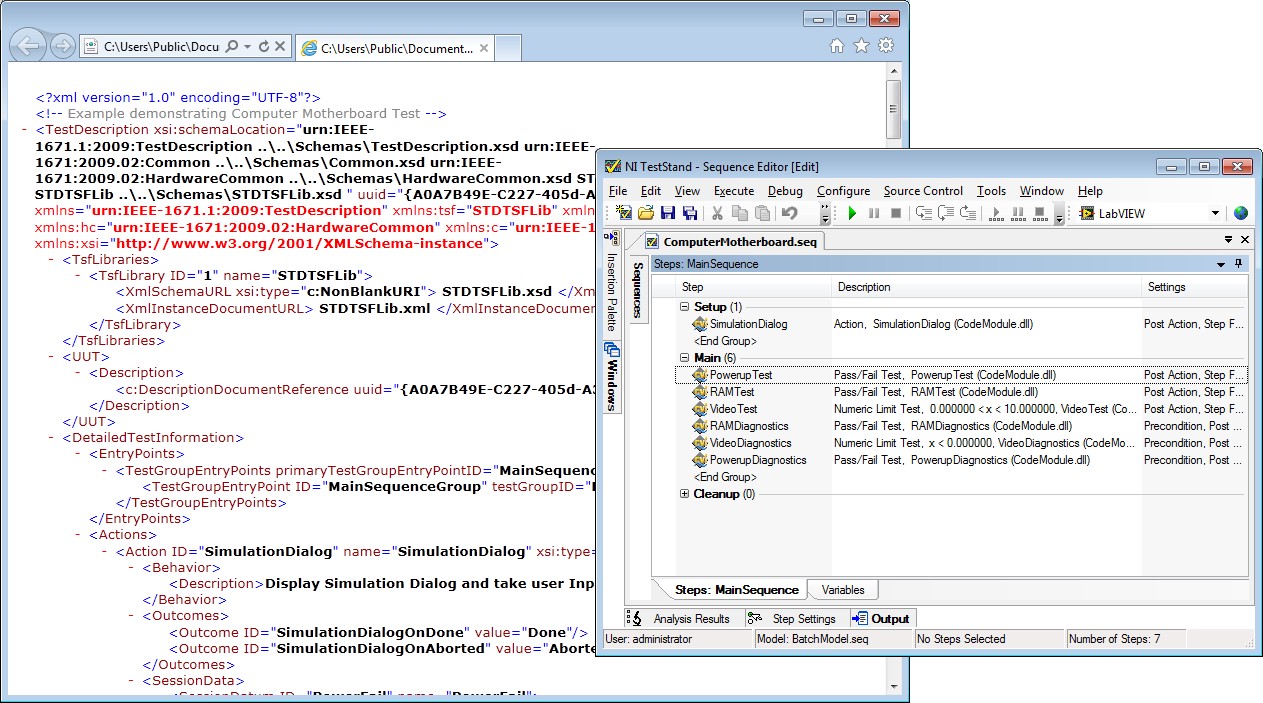ATML – The Standard for Interfacing Test System Components Using XML
Overview
Contents
- Lack of Standardized Data Exchange Driving Up Costs.
- Inside the Automatic Test Markup Language
- TestResults Schema
- TestDescription Schema
- The ATML Reality
- Perfecting a Standardized Data Exchange Interface
- References
Lack of Standardized Data Exchange Driving Up Costs.
The lack of standardized ATE and test information data exchange among the enterprise, other organizations, their suppliers, and OEMs contributes significantly to product development overhead costs. This is especially prevalent in the mil/aero industry, where typical units costing millions of dollars consist of hundreds of subsystems and involve dozens of mil/aero contractors and suppliers.
Inside the Automatic Test Markup Language
The ATML working group members have been holding quarterly meetings for more than two years to work toward establishing an IEEE standard that provides increased industry and mil/aero ATE system compatibility and modularity. The group is focused on establishing a standard that provides and manages extensibility while supplying an exchange format that both humans and machines easily can interpret.
In addition, the ATML standard is designed to improve several areas of ATE and test system design by:
- Implementing dynamic test sequences that adapt to historical data
- Supporting instruments and their interface setups
- Capturing test information at various test stages
To facilitate data exchange among system interfaces, stations, and manufacturers, and to ensure asset interoperability, the ATML working group has defined several external interfaces on which to standardize, including test result reporting, diagnostics, test description, instrument description, test configuration, UUT data, and the test station. Drawing on these interfaces, the working group has defined eight ATML components built on a ninth common component for an XML data interface (Figure 1).
Figure 1: ATML component interfaces facilitate data exchange and ensure asset interoperability.
While not all of the schemas are final, it is beneficial to look closely at the overall ATML structure and one of the approved schemas. For a detailed list of the ATML schemas and their current statuses, visit https://standards.ieee.org/ieee/1671/4514/
XML-Based ATML Structure
The ATML data exchange file is in ASCII text format with system-interface-specific tags, or elements, organizing the data. It is the ATML schema that defines the specific elements and their hierarchy within this data exchange file. Because the text document is a file containing descriptive tags, it can operate on any platform, and a computer program can easily interpret and parse the tags based on the schema. For those same reasons, it is human-readable.
Because ATML uses the XML standard for describing ATE and test data, it takes advantage of recursion and extensibility, key technical benefits that give test systems greater flexibility in defining interfaces. By supporting recursion, element definitions describing test properties or tests can nest to create a more managed data exchange format. In XML, test information extensibility adds data elements without disrupting current system operation. The ATML standard also includes general-purpose elements, such as OtherData and Extension, that can store additional information not specifically outlined in the ATML schema. All ATML-compatible systems can handle these miscellaneous elements differently or not at all and still operate correctly. Thus, ATML-based applications provide inherit extensibility to maintain compatibility among systems, while also maintaining flexibility.
To gain further insight into an ATML component, here is a look at the ATML TestResults component, which describes how test results should be organized.
TestResults Schema
As ATML defines, a test is any procedure for evaluating or quantifying the operation of a device or system. The TestResults schema provides a standard format for exchanging and storing measured values, pass/fail results, and accompanying data (including test operator, station information, and environmental conditions).
TestResults Example
The following example demonstrates the TestResults reporting by using NI TestStand, ready-to-run test executive software for organizing, controlling, and executing automated test systems. There are three steps to ATML reporting behind the scenes of an NI TestStand sequence execution. The first is the result collection by the NI TestStand engine into the NI TestStand ResultList container. The system tracks and stores all test properties, characteristics, and values in the ResultList container. The second step generates a TestResults schema-based XML report using the data in the ResultList container. The third step is the application of an ATML-compliant TestResults stylesheet that formats and displays TestResults XML data in a user-friendly HTML format. To further illustrate the TestResults schema, the ATML TestResults report in Figure 2 is generated from an NI TestStand example test sequence shown on the same figure. This sequence is a simple computer motherboard test on ROM, RAM, video, and keyboard components, as well as the CPU and power subsystem.
Figure 2: An example of an NI TestStand ATML test report stylesheet displays TestResults XML data in a user-friendly HTML format.
Upon executing the example test sequence, NI TestStand automatically collects each test step result and generates an ATML TestResults-compliant test report that it stores as an *.xml file. Storing the test report in this format means other systems can easily interpret the test result data and share information because the pertinent data is organized in a standard hierarchy within known tags' defining elements.
TestDescription Schema
The ATML TestDescription schema seeks to describe the test conditions, limits and execution of a set of tests. By standardizing the way the execution of a set of tests is described ATML increases the interoperability of test sequences by allowing a test description to be run on different test systems.
TestDescription Example
One of the challenges of implementing the TestDescription schema as part of a test executive is converting a TestDescription file into an executable sequence of tests. Custom built test executives are usually hard coded to read only one custom sequence file format and will not support TestDescription without significant development.
In contrast, the NI TestStand ATML Toolkit can automatically generate a skeleton TestStand sequence (as well as skeleton code modules in LabVIEW or LabWindows/CVI) from a TestDescription document. In addition, the ATML Toolkit offers a custom code generator framework to extend the code auto-generation with any custom logic.
The example in Figure 3. shows a sample TestDescription ATML document that describes a computer motherboard test, as well as the auto-generated TestStand sequence that implements the test described by the document.
Figure 3: An example of a ATML TestDescription document, and the NI TestStand sequence that was automatically generated by the ATML Toolkit


